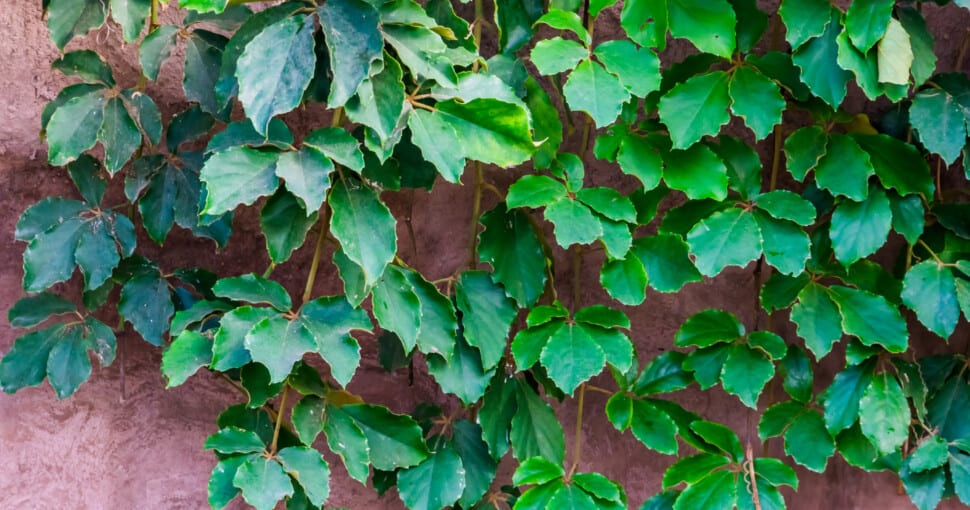Grape vines are attractive plants with their showy leaves, curling tendrils, and luscious fruit. They can live to be very old, with vines in Australia reaching over one hundred and fifty years. Some Californian vineyards boast vines planted in the 1880s that still look good.
Grape vines are thought to have first grown in the Mediterranean region and Southern Europe. They are one of the oldest plants on earth, having a history that dates back sixty-five million years. Grape vines are not just grown by commercial farmers and winemakers. They are also popular with gardeners for their aesthetic appeal and functionality.
Grape vines have woody stems that thicken and become gnarled with age. Initially, the stem is green in a young plant, but as the vine matures, the stem becomes brown with a tough outer layer. Tendrils fasten the grape vine onto a supporting structure such as a tree, pole, or trellis.
Grape vines have leaves with three to five lobes. Some people describe the leaves as heart-shaped. Certain cultivars have deep lobes, and others have shallow lobes with a barely noticeable fenestration. The leaves are three to eleven inches long, and the margins are toothed. The upper surface is bright green and smooth. The lower surface is paler and has creamy white or light brown hairs.
Grape vines bear clusters of small white flowers that bloom for a week or less before beginning the process of forming berries or grapes.
Related: 5 Plants That Look Like Grapes
1. Boston Ivy
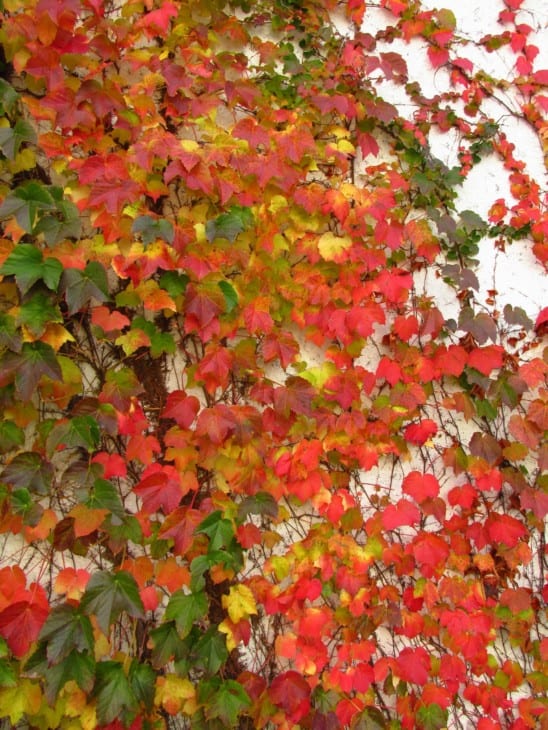
Boston ivy (Parthenocissus tricuspidata) is also known as Japanese ivy, Cottage ivy, and Grape ivy. It is native to China and Japan but has become a popular plant worldwide. It is often planted where it can grow up the walls of buildings. Boston Ivy covers many prestigious school buildings giving Ivy League Schools their name.
Boston ivy is a fast-growing creeping vine or liana. It is deciduous or semi-evergreen, depending on the climate. Boston ivy is a hardy plant that may be used as a climbing plant or ground cover. It attaches to structures using aerial roots and may be planted on walls to reduce heat absorption and cool the building.
Boston ivy has lobed leaves with toothed edges similar to grape vine leaves. The leaves may be red when they first emerge in some cultivars. Most Boston ivy cultivars have fall colors. The leaves change to russet, flaming orange, and old gold as the temperatures drop and the days shorten.
Small greenish-white flowers can be seen on Boston ivy in late spring or early summer. These give way to purplish-black berries that are popular with birds but toxic and inedible for people.
2. Passion Fruit Vine
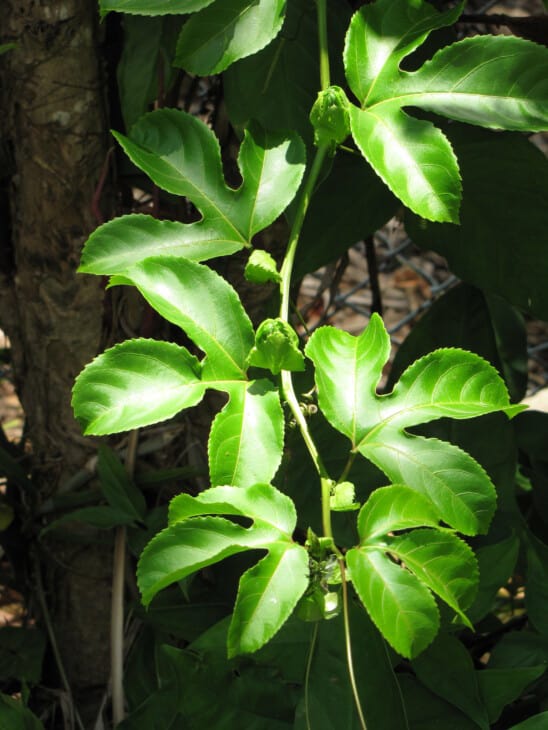
Passion fruit (Passiflora edulis) is an evergreen vine that may also be called granadilla. It is native to Brazil but has become naturalized across Australia, Africa, and many parts of North America. It is declared an invasive weed in some countries as it competes with indigenous plants.
Passiflora is a hardy perennial herbaceous climber that attracts many pollinating insects. The leaves have three distinct lobes, similar to grape vine leaves. They are shiny green to yellow-green on the upper surface, with the under surface slightly lighter colored. Like grape vines, it climbs up structures using tendrils.
Passiflora edulis produces a large purple and white fringed flower that lives for only a day or two. The flower quickly dies and begins forming an edible berry known as a passion fruit or granadilla. The fruit is green but turns yellow or dark purple to black as it ripens. The inside flesh is yellow or purplish, depending on the cultivar.
Passion fruit vines are tropical or semi-tropical plants that do best in warm, humid conditions. They do not tolerate frost and die easily in icy winters. They tolerate most soils and grow best in full sun.
3. Porcelain Berry
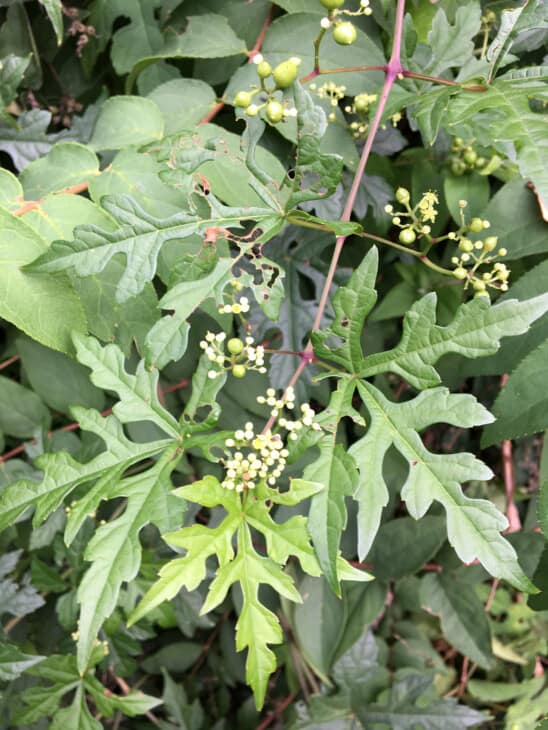
Porcelain berry (Ampelopsis brevipedunculata) is a member of the Vitaceae family, like grape vines. It is sometimes called the Amur pepper vine or wild grape vine. It grows indigenously in the warmer areas of Asia but has naturalized in many countries, including the United States, where it is an invasive alien.
Porcelain berry grows in full sunlight on the edges of forests, the banks of streams, ponds, and rivers, and around cultivated fields. It quickly takes over disturbed soil and can be seen on the sides of roads, railway lines, and long-term construction sites. It looks very similar to grape vines and is often mistakenly identified as a grape vine.
Porcelain berry vines are perennial, herbaceous plants with woody stems like grape vines. It climbs up trees and other structures by attaching itself with tendrils. Porcelain berry vines can easily reach twenty feet in length.
The leaves are lobed and have toothed margins, like grape vine leaves. The leaves are usually green, but some cultivars have pink and white mottling. Porcelain berry vines are deciduous, losing their leaves in winter. They bear small berries that may be pink, blue, green, yellow, or purple on the same plant.
4. Crimson Glory Vine
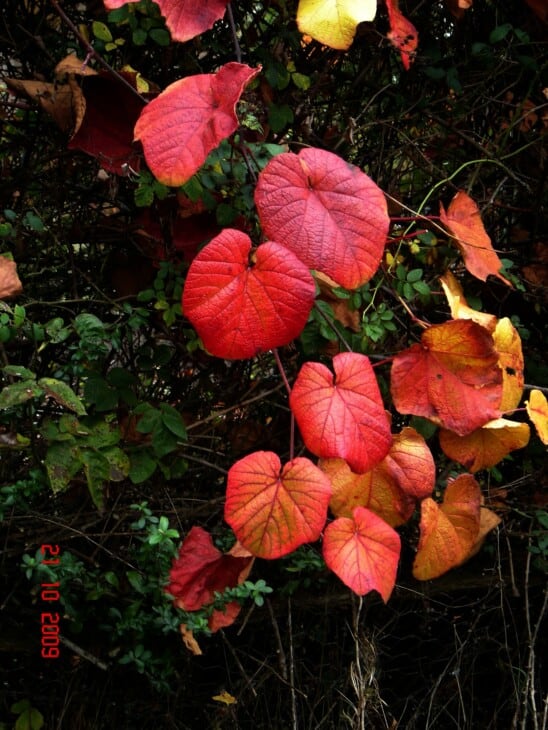
Crimson Glory vine (Vitis coignetiae) is from the same family as grape vines. It is also a deciduous woody climber that covers buildings, trees, and other structures. It originates in Japan but is popular worldwide with gardeners and may be seen growing in gardens on many continents. It is a vigorous plant that grows eight to sixteen feet in one season.
The Crimson Glory vine has large lobed leaves. It is best known for its wonderful fall foliage colors. The leaves put on a magnificent display of intense red, orange, and yellow that last well into winter when the temperatures become icy. It has small greenish flowers, which are often overlooked. These give rise to the development of small black berries.
Vitis coignetiae grows in full sun or partial shade. It is tolerant of most soil types but prefers well-drained ground. It is popular with gardeners that want to cover an unsightly wall or fence. Many people choose this plant to cover pergolas and arbors. It can grow up to fifty feet long, so it will need some pruning to control it in smaller areas.
The Crimson Glory vine does not attach itself to structures. The gardener needs to attach the stems and branches to the structures. This feature allows the plant to be trained in the desired direction. It is a low-maintenance plant that only requires pruning.
5. Fox Grape
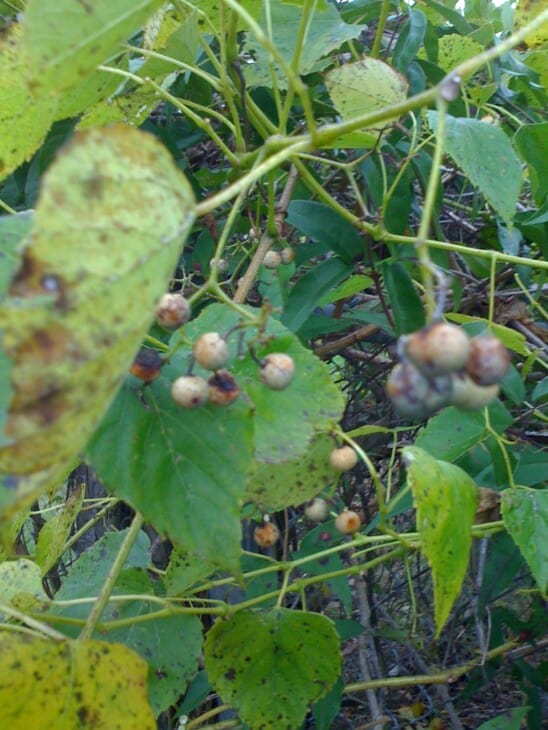
Fox grape (Vitis vulpine) has many other names. It is also sometimes known as Chicken grape, Frost grape, or Wild Grape. It is indigenous to the region around Chicago. People thought that foxes were attracted to this vine and its fruit. It received both its common and Latin name from this belief. Vitis also received the name Frost grape because the grapes are sour until the first frost, when they become sweet and pleasant to eat.
Like regular grape vines, Fox grapes live a long time. They can reach up to eighty-three feet with appropriate support. Fox grapes grow naturally in wooded areas, but they may be cultivated in gardens and on the sides of buildings. Fox grapes have a woody stem and lose their leaves in the winter.
Fox grapes have lobed leaves with toothed margins, just like grape vines, and the two may be easily confused. They bear insignificant flowers which produce purple-black berries or grapes. The grapes are edible, and if left on the vine into winter, they dry up and produce raisins. Wild animals and birds feed off the grapes, and the raisins provide good winter food for them.

